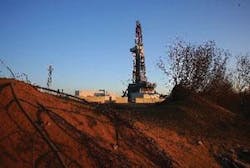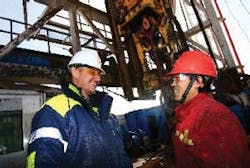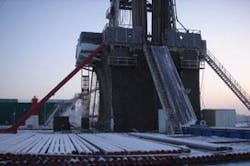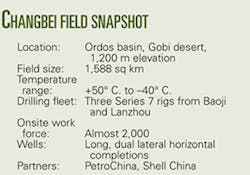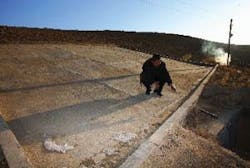CHANGBEI WELLS—Conclusion: Shell drills long horizontals in China
The Changbei field area in the Ordos plateau, at the southern tip of the Gobi Desert, is twice the size of Beijing city and expected to supply dry methane to Beijing for the Olympic Games that begin Aug. 8, 2008.
Shell drilled the first of the dual lateral horizontal wells in 230 days, but the most recent took only 186 days. In 2½ years of operations, Shell has refined and optimized the drilling process, but the Changbei project still faces contractual gas deliveries for 2008. This requires completing at least six additional dual lateral wells this year. Because Shell and its partner PetroChina are the first to drill and operate this type of well in China, there are no benchmarks to follow and the steep learning curve continues.
New ways of working
The project started out with two new and one 4-year old Series 7 rigs (capable of drilling 7 km) built by two Chinese corporations: Baoji Oilfield Machinery Co. Ltd., in Shaanxi Province, and Lanzhou, in Gansu Province. It seemed at first that most of the Chinese rigs were working for Great Wall Drilling Co. In fact, this company is an agency that looks for projects outside China and then farms them out among Chinese companies such as Changqing Petroleum Exploration Bureau and Liaoche Petroleum Exploration Bureau. Each rig has a unique number (such as 70156), which indicates the rig capabilities, age, and even where it has been drilling. This helps the technical evaluation during tendering for rigs.
Contracting rigs is a unique experience in China, where the custom is to negotiate after the signing as to what the specifications, in fact, mean. Chinese drilling companies tend to be compartmentalized into various departments, each separately managed. For example, a drilling contractor will have a materials department that lends it the equipment, a financial or purchasing department that supplies spare parts, a transport department for the rig move, and so on. The friction that can arise between departments is not transparent to outsiders.
In addition, the companies’ somewhat rigid hierarchy creates safety risks because each department’s own safety culture can be different from that of the drilling contractor on site. Often the drilling contractor needs to smooth the path before a service is needed.
Wells
The Changbei wells are dual laterals; both legs are drilled to about 5,400 m, demanding a high degree of accuracy because the pay zone is thin. The clay formations of the Ordos plateau are hard and the reservoir sands abrasive. This makes the Changbei wells capital intensive, even though the rigs are probably among the cheapest of their kind at present.
Some equipment is starting to show wear 2½ years into the project, due to harsh drilling conditions, substandard maintenance, procedures, and gear. This is especially true of drill pipe strings. Frequently, drill pipe boxes split and wash out, resulting in fishing jobs and scrapped pipe. Shell formed a special team to identify the causes and rectify the problems. So far it has become clear that the pipe handling is not good and the locally sourced power tongs used to make up the drill pipe cause deep stress initiation grooves on the high torque tool joints.
Quality
This illustrates the struggle that Shell faces when it comes to delivering high-quality wells. Each of the new horizontal wells costs about four times the cost of a vertically drilled and hydraulically fractured well common in this part of China. Shell has to prove the horizontal well technology and at the same time find a delicate balance between cost and quality to defend the right to be working here.
The cost-quality ratio is present in every aspect of daily drilling and completion work. For example, a local wireline crew will consist of 11 people, each with assigned tasks, be it driving the truck or making up chicksans. A cement crew consists normally of as many as 20 people. The availability of such large crews often means that the preventive maintenance traditionally done in the yard is replaced by corrective maintenance done at the wellsite.
Hierarchy
The hierarchy within Chinese drilling companies sets them apart from operations in other parts of the world. Team consensus through meetings may be the norm for western companies, but the Chinese way of working is based on commands through the line. This sometimes leads to hidden shortcomings in operations due to the fear of retributions from further up the line.
The example of “correct” reporting is appropriate, in which many parameters such as mud properties, spare part inventories, and equipment data are always reported within the planned window of values. Making assumptions or troubleshooting based on those kinds of information can lead to wrong and often costly decisions. For example, Chinese equipment does not always have all the correct specifications.
Chinese drilling contractors generally like to buy foreign drilling equipment, rather than to rent it. They perceive that contracts to service this equipment are too expensive, so the crews on the rigs do the maintenance themselves. The drawback is that carrying out repairs and getting spare parts are more cumbersome at times. Shell and the drilling contractors together have set up a successful preventative maintenance system (PMS) that is paying off now. The systems have been earmarked for use on more Chinese rigs elsewhere.
The project uses the newest Halliburton rotary steerable tools on a Geoforce motor, which allows a faster buildup section in the 12¼-in., with PDC bits, rather than rock bits. It is this cost-quality ratio that Shell aims to achieve in its operations to deliver the next six wells before the end of this Chinese year in order to fulfil the gas target.
The 2007-08 winter will be the harshest in China in more than half a century. Although it is too cold and dry in Yulin to have a lot of snowfall, rig winterization is key to be able to operate year round. Avoiding nonproductive time (NPT)is essential during long periods when temperatures dip down to 30°. Logistics during this winter and with CNY have been complicated as heavy snowfall has forced road closures. The wind over the plateau adds to the chill factor.
Drilling crews work normally 9 months on the rig and are off for the rest of the year, when the rig goes idle over winter. The length of wells make it necessary to drill year round; crews are on 5-week rotations in Changbei. Therefore, there is no local experience to run the winterization package optimally, although the team has been able to avoid large NPT events with the right amount of boilers, heaters, and operational changes.
From the start, Shell made it priority to increase the Chinese content of the Wells team. Mature hires, graduate hires, and in particular, Petrochina seconded staff, have benefited from becoming familiar with international operational standards in drilling and well-service technologies.
Since the start of the development program in fourth-quarter 2006, 33 staff (Chinese nationals and expatriates combined) were provided with Shell Wells’ distance-learning package. Through the end of January 2008, 15 staff members (13 Chinese nationals) had successfully completed Round 1, of which 9 members (7 Chinese nationals, including PetroChina seconded staff) have completed the Round 1 exam. Excellent performance, combined with satisfactory results in passing the R1 exams, made it possible to promote a few experienced Chinese wellsite staff from night to day supervisory positions.
If the pace of self-study and dedication to become a competent Wells staff member continues, one can reasonably expect 13 staff to obtain an R2 pass by mid-2009. This would permit a healthy and justifiable progression of junior staff to senior positions, thus reducing the expatriate content of the team, as intended.
Progress, milestones
After the Changbei field has been operating for more than 2 years, only eight wells have been completed. Even so, Shell’s partner, Petrochina, believes that many milestones have been achieved. The first and foremost is a large advancement in technology.
Drilling the longest horizontal wells in China in both 8-in. and 6-in. hole sizes is substantiating that Changbei field-development plans are correct. Out of these wells, six have a higher than planned initial and continuous production, proving that reservoir impairment has been prevented, even though the sands are generally tight and low pressured.
The second milestone is in HSE performance. Only two minor lost-time incidents have occurred. Both PetroChina and Shell intend to reach this year’s safety target for the Changbei project. PetroChina is confident that if the new learning curve can be achieved the contractual target can be met. It can use the technical and HSE expertise well in its other operations.
Drilling obstacles, solutions
Generally, Chinese drilling contractors are unfamiliar with the concept of NPT and key performance indicators. Because the mother company decides which rig and operation has precedence, if a rig has to wait, it is accepted. Most Chinese rigs are contracted on a lump sum basis. A contractor will get paid only after reaching an agreed depth in the well or hole section.
Changbei contractors initially liked the daily rig rate because even when operations had delays due to mechanical issues they still got paid. There were no discussions concerning the final monthly billing sheets. This changed rapidly after they realized that the total of rig rate and standby rate could quickly be consumed and change into a zero rate with increasing downtime.
SCEPCO is now actively working with the contractors and moving to a win-win midpoint with an incentive structure, based on overall actual vs. planned well timings. Given the mix of languages, practices, and cultures, communication can be a major problem. To get to the bottom of things one has to be very precise and ask only open questionsones that can not be answered with a simple yes or no.
Chinese drilling companies do not work with the concept of a tool pusher. Rig supervisory staff include a drilling engineer and a rig manager. Most of the time, the DE and RM are the best educated, but often lack rig floor experience. For the Changbei project, tool pushers have been appointed, but the modus operandi at other Shell locations has to be carefully revised to prevent shortcomings in communications and hence operations.
By far the largest factor for lost time in the wells has been problems in drilling the bottom of the 12¼-in. section. The formations in the Shanxi are hard mud and clay stones, interbedded with fragile coal seams. These seams can fail, causing large, hard cavings to fill the wellbore and resulting in stuck pipe and mud motor failures due to large bending stresses over washed-out sections. The team has come up with special procedures and BHA configurations to avoid these events and improve ROP. Currently, there is a drive to optimize the use of PDC bits and minimize sliding with mud motors.
The regional team of experts in Miri, Malaysia, together with two mud specialists in the field have come up with an improved KCl-based drilling fluid that is currently being tried. This is key to avoid losses in the upper Liujjiagou formation while preventing large cavings in the Shanxi formation and retaining a contingency to clean the wellbore in case cavings occur. The mud is pretreated with various lost-circulation materials. All these measures increase the chances the drillers will get the long 95⁄8-in. production casing into the Shanxi pay zone.
Lately, more liners have had to be dropped off in the openhole reservoir holes to stabilize (carbonaceous) shales that can collapse during production. So far, all 7-in. and 4½-in. perforated liners have been successfully installed. Also, due to unexpected subsurface conditions, it has been necessary to install intermediate 7-in. cemented liners. Drilling the subsequent 6-in. section required special attention to torque and drag, but good progress has been made to get to an acceptable drainage-leg length of 1,900 m.
Drilling such lengths of 6-in. annulus is only possible by using stiffer 4-in. (heavy weight) drill pipe. Staff at the real time operating center (RTOC) in Miri aid the directional drillers and drilling supervisors by modeling the optimal bottomhole assembly and pipe configurations. A contracted bit specialist in the operations team has been working on improving the 6-in. rock bit design for longer bit runs.
Where the 8½-in. bits experience considerable gauge wear, the 6-in. bits normally have bearings fail before the bit reaches the end of its useful life. All these iterations have resulted in a slimmed-down well design as a viable option for the future and a dependable contingency when dealing with unstable shales in the reservoir sands.
Learning curve
Shell worldwide is working to implement LEAN-SIGMA improvement methodology that complements Shell’s drilling-the-limit tools. LEAN is more a philosophy and a toolbox to analyze and improve drilling than the in-house process that DTL used to be. The LEAN approach comes from the automotive and production industry, having been successfully developed by companies like Toyota and General Electric. But, how do boreholes 3 km underground compare to making 2,000 cars or 5,000 electric razors each day?
It’s not the reduction of statistical failure and waste-products that Shell is after; it’s the mapping of drilling processes and the identification of nonvalue-added steps and wasted time that help to improve delivery of wells and reduction in failure events. DMAIC involves: Making detailed process maps (Defining) and timing the steps (Measuring), looking carefully at the value and problems of each step (Analyzing), learning from good or bad practices (Implementing), and sharing the results (Controlling) to achieve better and more uniform performance.
Drilling rigs are run by people, not robots, all with different ideas and experiences on how best to drill the well and prevent train wrecks. The LEAN process helps to capture the best efforts and practices worth duplicating and makes them visible for others to improve, especially between departments. Successful LEAN projects currently under way in the Changbei project include 6-in. hole drilling, tripping, casing running, and moving rigs, but the first success story of a LEAN implementation was the tie-in of Changbei wells. Previously it took around 40 days from the rig having left a cluster to first gas; now it takes 14 days. This achievement has been realized by better scheduling and safe, concurrent operations by the wells, well services, engineering, and operations teams.
The LEAN process has facilitated communications and eliminated misunderstandings. It is a commendable effort, realizing that it takes 150 truckloads to move a rig, every well has to be lifted with coiled tubing and nitrogen and cleaned up via temporary pipe work to a flare pit for about 5 days, tied into the cluster facilities with other wells already on-stream, and then introduced to the central production facilities. Efforts are ongoing to realize the next step in the process, in which new wells are cleaned up directly at the facilities, negating the need for the results of production testing to enter the atmosphere.
Because logging while drilling is not cost effective, Shell has always conducted borehole evaluation as a separate run by pumping and rotating out of hole. Recently, Shell has successfully introduced shuttle logging, in which smaller tools are brought to depth efficiently inside drill pipe, then pumped out and pulled back to surface without having to pump through the string. This process has saved about 2 days/leg since its introduction.
Further improvements towards the goal of 160-day wells have been achieved with the use of agitators and variable gauge stabilizers (AGS) for both 12¼-in. and 8½-in. holes. Because depth control is much stricter than the lateral control, an AGS sub is effective in improving the rotary vs. sliding ratio. Sliding at depth is harder to manage and thus results in lower penetration rates. Using the agitator has been proven to promote the weight transfer to the bit and, as such, helps with a steady tool face in case sliding is required. With all of these efforts the team is confident it can achieve good results.
Last summer, a 17-member electric line crew deployed a tractor-conveyed PLT string over a lateral junction to evaluate the contribution of each leg in a well that had yielded disappointing results. The next step in our technology staircase will be to introduce a capacitance array tool to better understand the reservoir inflow mechanism of the Changbei wells.
As of February 2008, the three rigs in Changbei had achieved more than 1,050 days without incident in the middle of the Gobi Desert.
Record leg
In October 2007, the longest horizontally drilled leg was superseded again by the drilling of CB3-2 leg 1 to a length of 2,251 m, proving that it is possible to drill such lengths in abrasive narrow sandstones with water-based mud.
Acknowledgment
The author acknowledges the contributions of Vladimir Bochkarev, Adrian Wevers, Frans van Hoorn, Cyril Dalmas, Aart Boendermaker, Gerard de Blok, and Chen Zhiyong.

